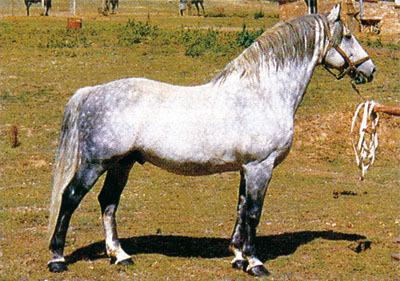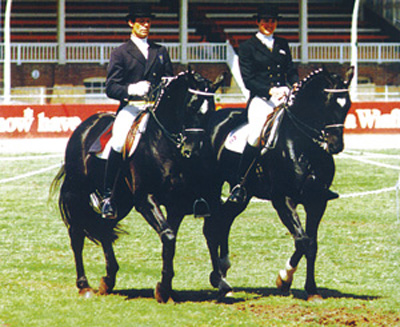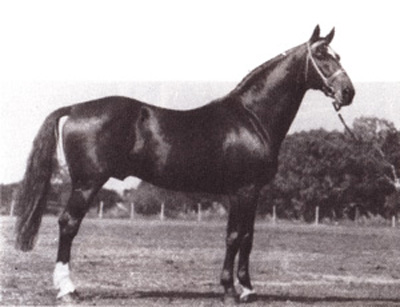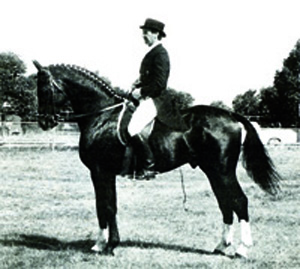At the end of the Second World War, the tractor was taking over the Agricultural sector and the future was looking grim for our friend, the horse. Then something very exciting happened, equestrian sport, previously reserved for male military officers, started to boom all over the world! The first World Showjumping Championships were held in 1953, then the first Eventing and Dressage World Championships were held in 1966. Suddenly the horse was back in demand, and the hunt was on for riding horses, for competition horses for the newly popular sport.
In Australia, there were a number of attempts to breed sporthorses. There had always been the traditional Clydesdale cross, some – to the great amusement of the French – tried Percheron, others experimented with Connemaras, Palominos, Andalusians. One enthusiast, Mrs Jackson in Victoria, set up a breeding program seeking to marry the strengths of the Thoroughbred, the Arabian and the Clydesdale, to produce the ultimate sporthorse. Mrs Jackson even employed one of the first émigré riding instructors, Kornel von Feuchtesleden, formerly a major in the Royal Hungarian Hussars, to train the horses.
No, the mix didn’t work, it was probably our first lesson that trying to marry radically different types seldom works, but it was a lesson we had to learn a few more times before it sunk in.
Influenced by some of the newly arrived European riding instructors, the Australian breeders and riders looked to Europe, and in particular, Germany…
The First Warmblood!
The very first Warmblood horse to come to Australia was a Holsteiner, the stallion, Flaneur, imported in 1968.

By Fax I out of Lita by Markgraf, Flaneur was described by Dr Friedrich Rossow in his official Holsteiner Verband stallion book as ‘awkward and stubborn under saddle’. It was perhaps not a great way to introduce the breed to a new country… especially as the interest in Warmblood breeding was almost exclusively concentrated on producing dressage horses. At that time, Australian jumping riders were happy to make use of the endless supply of very inexpensive failed racehorses coming off the racetrack.
The stallion was imported by Don Paul, who had been a prisoner of war in Eastern Europe during the Second World War. At the end of the war, Don joined the flood of refugees heading down the highway back into Germany. He was walking alongside a ‘little German on a big horse’ who had a whole string of horses he was trying to keep together. Every time a plane went over, the horses scattered, but since the German had been kind to him, Don Paul helped him get his horses together. Eventually he ended up riding one of them.
Back in Germany, the rider, who was returning the horses to his father’s stud, said farewell to his fellow traveller. He was Fritz Thiedemann, who in 1953 won the silver medal at the first World Showjumping Championships. He also gave the Australian his address.
So many years later when Don Paul wanted to buy a German stallion he wrote to Thiedemann, who sent him some photos of horses he considered suitable to breed over Thoroughbred mares – Don Paul chose Flaneur and imported him, sight unseen, to Australia.
Nonetheless, Flaneur, ridden by another import, this time former German cavalry officer, Antoine Nissen created something of a sensation when he was displayed at the various agricultural shows and horse events around the country. For a start, Australians had never seen a riding horse quite that big – 17 hands and three inches! It had been Nissen who had suggested to Don Paul that Australia needed a German stallion.
Australia’s first performance horse breeding association was established in 1970 – the Holsteiner Breeders Association of Australia – but this soon became the German Warmblood Breeders Association.

The Dutch stallion Arnhem arrived in 1974 – imported by Graham and Heather Weir. Gert Donvig imported the Danish stallion, Kilof McOhl in 1976. 1976 also saw the importation of the first Hanoverian licensed stallion, Domherr, brought to Australia by Roz Oatley and her then husband, former German Junior Dressage Champion, Reiner Nist. Domherr was later to become famous as the sire of the Barcelona eventing gold medallist, Kibah Tic Toc, ridden by Matthew Ryan.
And lest you get the impression that all those early Warmblood breeders were – like their horses – foreign imports, there’s Bev Edwards – she was Bev Chugg then. She turned to breeding performance horses when her son Chris was 12 years old.
“It was basically to breed jumping horses for him. I was doing a bit of eventing, and I was sort of sneaking into dressage. I’d had a few schools with Franz Mairinger. Before that it had just been the hacks and the hunters.”
“I got into trotting horses as well. I trained quite a few trotting winners, I was actually the first woman to train a trotting winner at Harold Park. Also the first woman to get license in Sydney.”
Bev purchased her first stallion, the Quarter horse, Chico d’Oro in 1971. The horse was a B grade showjumper and took the by then 18 year old Chris out of the junior ranks and into open competition.
Chico also bred a World Cup showjumping final representative in Aschico, and a WEG dressage team member in Peaches ‘n’ Cream.
Then in 1977 Bev acquired the Hanoverian, Sky High – whose story is to be found later in this history. Sky High was one of the first Warmbloods to make the showjumpers sit up and take notice.
The early breed Associations
1978 saw the arrival of two more Holsteiners, Contact and Romedio. Two Australian bred stallions Schwandor and Boss Cockie (both sons of Flaneur) were also registered that year. 1979 was a big year for stallion imports: Ralph Grosby imported King, an Oldenburger and Düellschutz, a Hanoverian. King was the sire of John Fahey’s showjumping stallion, Attilla Rex, and the advanced eventing stallion, Abduell, while Düellschutz sired the first Australian Warmblood to compete at the Olympic Games – EBA Schnapps. Cheryl Hunt imported the Hanoverian, Adlerstein and the Trakehner, Fred Astaire, Gert and Mary Donvig brought out another Danish horse, Granada and another Dutch stallion – Abel Tasman – arrived. It was time for a name change and the Australian Warmblood Horse Association was born in 1978.

Meanwhile in Victoria, breeders who wanted to keep alive the Flaneur influence banded together as the Holsteiner Breeders Association of Australia with the inaugural meeting on April 28, 1974. At this inaugural meeting, Malcolm Barns displayed the Flaneur son, Schwandor.
According to Ann Hunt in a report in The Horse Magazine (July, 1989, page 51):
“It was the public’s first viewing of the breed in action and they were enthralled by the two year old’s free jumping display as he trotted calmly up to substantial obstacles and sailed over them with consummate ease…. The aim of the Australian Holsteiner Horse Association is to produce a well-balanced, sturdy horse standing 16-17 hands as an ideal with round generous strides and a natural elastic movement.”
“The Association is committed to adhere as closely as possible to the selected breeding standard practised since the 13th century – given certain obvious geographic and administrative differences.”
But, and this is a recurring theme in Australian performance horse breeding history, yet another stud book appeared in 1977 as the Victorian Warmblood Horsebreeders Association. In 1983, the association was re-named: The Australian Warmblood Sporthorse Association.
For many years, the AWSHA was led by Warrick Cozens, an Australian rider who had spent six years in Europe in the late 60’s and early 70’s, studying with some of Europe’s leading trainers, including Fritz Tempelmann, Egon von Neindorff, Georg Wahl and three and a half years with Col. Alois Podhajsky. In 1971, Cozens brought home with him the stallion, Lucano, by the Hanoverian Luciano, and out of a mare by the Oldenburg based Selle Français, Furioso II.
Lucano (below) was the sire of Clifton Court Cognac, who competed at Grand Prix Dressage level with Paula de Visser.

The two main breed societies split over the issue of stallion approval. The AWHA developed a policy that favoured a European style system of licensing and performance testing and grew increasingly rigorous in its testing and controls over the years, while the AWSHA advocated a more laissez faire approach of letting the market – and competition results – identify the worthwhile stallions.
In a THM Breed Society Special in 1987, the AWHSA laid out its breeding policy:
“The AWHSA recognises all the European Warmblood Stud Books but directs its efforts to the promotion and development of an Australian Warmblood horse bred from the Warmblood horses of Europe and the Thoroughbred and Anglo-Arab horses of Australia to produce talented, well conformed and athletic Australian Sport Horses. The AWSHA feels this is best done by placing the responsibility for producing Australian Warmblood horses in the hands of the horse breeder, and with the minimum of interference give the horse breeder direction, guidance and help in continuing to improve and develop an Australian Warmblood Sporthorse… It has always been the AWHSA’s contention that expensive performance testing is a very limiting and daunting to many Warmblood breeders and, at this yet early stage of Warmblood breeding, restrictions of an authoritarian culling nature are not conducive to the progress of Warmbloods in Australia.”
“The AWSHA method of performance testing is done by taking into account the results of performances by sires and their progeny in the three Olympic disciplines of dressage, showjumping and eventing as well as show performances. The association offers guidance to its members but places the onus on each individual stud to be responsible for the quality of the horses they produce.”
(The Horse Magazine, page 84, August 1987)
In 1985, the AWHA, as distinct from the AWHSA, had 50 registered imported and Australian stallions on its books, the majority not performance tested. That year, the AWHA conducted the first performance testing of stallions in Victoria. Those that did pass: Abel Tasman, Fechtor, Fred Astaire, Northern Congress (Aust), Pfrinzen (Aust) and Valuta, joined Duellschütz, Flaneur, King, Kilof McOhl and Moselfischer (all tested overseas) as the only stallions in Victoria accredited by the AWHA at that time.
The AWHA continued to refine its breeding guidelines and by 1988, this was the policy:
“The AWHA has always been prepared to modify its breeding guide-lines for the improvement of the breed and has been the forerunner in many aspects of performance horse breeding. In 1985, with enormous support from our members, we introduced changes to our breeding program to bring it more into line with the German guide-lines. These changes included colt selection, a seven day stallion performance test, mare classification (warmblood and foundation) and the granting of breeding permits to stallions on an annual basis.”
“We are responsible for operating a Stud Book for approved breeding horses, and a Register for non-breeding purposes. We are in the process of introducing an additional register for performance only, to widen our acceptance of Warmbloods produced…. Our Association supports the performance testing of stallions and will not recognise a stallion unless it is performance tested by a recognised body overseas or the AWHA. As performance testing is synonymous with Warmblood breeding, we are not prepared to take the risk in waiting for stallions, or their progeny, to compete in open competition. This method of recognition is not only time consuming, but rarely ensures that each stallion performs in the three required disciplines of dressage, showjumping and cross country.” September 1988 THM
There was always a feeling – particularly by those who had stallions rejected (and yes, I was one, our Thoroughbred Valadero was failed) – that having a panel of assessors, some of whom were stallion owners, was a bit like putting the fox in charge of the hen house. Eventually history would answer the question of performance test or let the market decide, and the answer would seem to be that it didn’t really matter at all. There were some terrible horses produced bylicensed performance tested stallions, and many quite successful horses were by unlicensed, untested sires. And vice versa…
Next Month – Early Holsteiner lines

Hi I am trying to find a contact for the defunct Aust Warmblood and Sporthorse Association. You cite a Warwick Cozens, I have a mare registered with them with an incomplete pedigree from the Northern Stud in Queensland. I need to know more before I decide to breed with her. Can you give me any information on how to contact someone associated? Thanks Anne Stewart, Whangarei NZ.
Hi I am trying to find a contact for the defunct Aust Warmblood and Sporthorse Association. You cite a Warwick Cozens. Regards